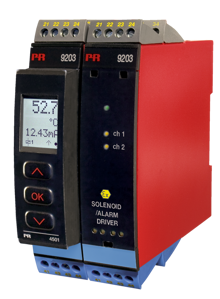Product Spotlight: The PR electronics 9203B Solenoid/alarm driver
Get an introduction to the 9203B and what it can do for you.
a) What is a “driver”?
- A driver is a device that outputs a powered signal or specified level of energy to other device(s). In a sense, a power supply is a driver, because it “outputs” a specified level of energy to other device(s).
b) What specified level of energy does the 9203B Solenoid/Alarm driver output?
- Each 9203B has three different outputs. Each one provides a specified peak level of voltage and current under normal conditions. If the 9203B should fail in certain defined ways, the peak level of current and voltage at each output could increase. These increased levels of current and voltage, and the maximum level of capacitance and inductance present at each output during fault conditions are specified in the 9203B “entity parameters”.
c) How are entity parameters used?
- Since a device's entity parameters define its electrical characteristics during fault conditions, the entity parameters of different connected devices can be compared to help determine if the devices and the wiring that connect them constitute an “intrinsically safe” system.
d) What is an intrinsically safe (I.S.) system?
- This is a system where the level of available electrical and thermal energy is so low that ignition of a flammable atmosphere cannot occur.
e) Where is the 9203B Solenoid/alarm driver used?
- The 9203B is used anywhere intrinsically safe levels of energy, like certified solenoids and alarms, need to be sent to devices located in a flammable atmosphere. This type of application is commonly found in chemical plants, and petrochemical plants, (e.g. oil refineries).
f) Can the 9203B be used to make a standard (non I.S.) device intrinsically safe?
- No. A standard, (non-intrinsically safe) device does not have defined entity parameters, thus the intrinsic safety of a 9203B in connection with a standard solenoid coil cannot be determined.
g) Are there any devices that are considered intrinsically safe, but which don’t have defined entity parameters?
- Yes. A simple device like a switch or LED might not require entity parameters yet would still be considered intrinsically safe. This is because these types of devices cannot generate or store more than a specified low level of energy. Simple devices like this still require an intrinsically safe device to be energized or measured.
